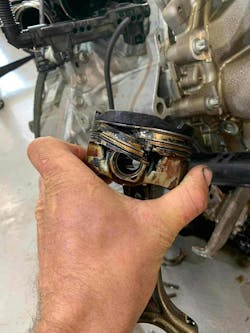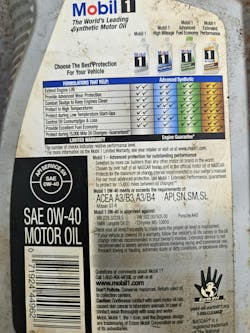Low Speed Pre-Ignition: Causes and How Engine Oils Combat It
Suck, squeeze, bang, blow. This simple idiom is taught to automotive students as an introduction to the four cycles that make up a four-cycle internal combustion engine: intake, compression, combustion, and exhaust. These events happening in time are the cornerstone of locomotion in four-cycle gasoline engines. But when the timing of these events is compromised, a change in a manner, regardless of how small, can often yield catastrophic results.
Low-speed pre-ignition, or LSPI, is a destructive, abnormal combustion event that occurs most often under low engine speed and heavy load conditions, like hard acceleration from a stop or “lugging” the engine up a hill in too high a gear. Unlike traditional pre-ignition or detonation, which can be managed with changes to octane or ignition timing. LSPI occurs suddenly, and the result can be severe: cracked pistons, broken rings, or bent connecting rods are not uncommon results of LSPI.
Over the past two decades, engine design and technology have evolved rapidly. Automakers have turned to smaller displacement, forced induction, and direct injection to help meet ever-tighter fuel economy and emissions standards. While these engines deliver impressive power and efficiency considering their displacement, it doesn’t come without its challenges. And just like how auto manufacturers had to turn to new technology to get efficiency and power, so too did they have to turn to new advances in lubrication technology, particularly changes in additive chemistry, to help curb this once-feared phenomenon.
What is LSPI?
Pre-ignition and detonation are nothing new. Pre-ignition occurs when the air/fuel mixture ignites before the spark plug fires, caused by a hot spot in the combustion chamber. Detonation is the uncontrolled combustion of the air/fuel mixture due to excessive heat and pressure. But LSPI is different. Where traditional detonation events happen at higher engine RPM and loads, often when ignition timing is too aggressive or fuel octane is insufficient, LSPI happens most often at low RPM and high load situations. Again, when the vehicle is accelerated hard from a stoplight, the engine is lugged up a steep grade or produces full boost at low speed. These situations create high cylinder pressures and temperatures, setting the stage for LSPI.
LSPI is dangerous because of its intensity and unpredictability. Events occur at random with high-pressure spikes, at times double what the engine was designed for. While traditional knock can often be detected and managed by the engine management system, it’s the unpredictability of LSPI that can make it catastrophic. These unchecked pressure spikes can easily crack a piston, shatter a ring land, or bend a connecting rod.
As turbocharged gasoline direct-injected engines became more common in the early 2010s, auto manufacturers saw an uptick in unexplained engine damage during durability testing. The industry quickly realized that they were dealing with a new phenomenon that required a new line of defense.
The science behind the phenomenon
Before we can talk about the important role engine oils have in preventing LSPI events, we need to take a look at why it happens in the first place. Multiple contributing factors lead to LSPI occurring. To borrow a common analogy from aviation accident investigation, think of all the contributing factors as individual pieces of Swiss cheese. Individually, these issues are often harmless, but stack them together with aligning holes, and you can find yourself with a clear path to failure.
Fuel Characteristics
GDI engines inject fuel directly into the combustion chamber, which has benefits such as precise fuel delivery, allowing for higher compression ratios due to GDI’s cooling effect, and leaner overall operation because of a stratified fuel charge operation. This allows for a greater opportunity for that fuel to mix with residual oil droplets on the cylinder walls and then enter the combustion process.
Engine Design
Forced induction allows more air into the combustion chamber, and when paired with downsized displacements, the brake mean effective pressure is significantly higher than their naturally aspirated counterparts.
Engine downsizing forces engines to operate closer to the maximum load more often, which increases stress during acceleration events.
Fueling directly into the combustion chamber, bypassing fuel encountering the intake valve, like you get when fuel is introduced at the port or via the throttle body, can lead to carbon deposit buildups that disrupt airflow entering the cylinder, affecting air/fuel ratio.
Operating Conditions
LSPI occurs most often at low RPM and high load, when drivers expect strong torque from their turbocharged engines.
There is still considerable debate on the cause of LSPI, but the general working theory is that oil and fuel interactions in the combustion chamber are the driving factor of this destructive phenomenon. During the intake and compression strokes, small amounts of oil can enter the combustion chamber by either bypassing the rings (blow-by) or via a residual film on the cylinder walls. Under high loads, this oil film can detach and form fine droplets. When mixed with fuel, these oil fuel droplets can auto-ignite before the spark plug fires. If normal ignition occurs around the same time, the overlapping flame fronts can result in pressure spikes that can significantly exceed design limits, causing forces that components in the rotating assembly were never intended to take.
Early industry response
When automakers first started experiencing LSPI, they were taken by surprise. The phenomenon was sudden and severe, and often the result was the need for complete short-block replacement. And because LSPI occurred so randomly and during normal driving, significant warranty and durability concerns were present.
Early responses from the OEMs were to limit torque output at lower RPMs by using engine tuning strategies. Controlling boost pressure and ignition timing under high load/low speed operation. While there was initial success in reducing the frequency of LSPI, it also lessened driver experience by dulling the torque-rich character that made forced induction vehicles fun in the first place.
Automakers realized that there was a chemistry component to the LSPI phenomenon. Researchers found that the calcium-based detergents used to help neutralize acids and provide rust protection could increase LSPI frequency by providing fuel for oil auto-ignition. General Motors was one of the first to recognize this issue and quickly developed an LSPI test as part of their dexos1 Gen2 specification. This standard change forced oil companies to reformulate their offerings to meet the new requirements and proved to be a turning point in addressing root cause of LSPI.
Role of engine oils in LSPI mitigation
It didn’t take long for the industry to realize that LSPI was not simply a hardware issue, and quickly the focus turned inward to the fluids circulating within the engine. Researchers discovered that oil chemistry had a significant impact on LSPI event frequency. Oil additive and detergent packages, used for wear and deposit control, could elevate or reduce the risk depending on what is used.
Calcium-based detergent packages had been the standard for decades for controlling deposits and neutralizing acids in engines. Calcium, while very effective for cleanliness, was also found to elevate LSPI events. When oil droplets enter the combustion chamber, the calcium compounds act as ignition promoters when mixed with fuel. This lowers the threshold for uncontrolled pre-ignition. This happens because when the calcium reacts with the fuel, it forms a new lower-octane compound. The lower-octane value of this new compound makes it prone to auto-ignition when subjected to the cylinder pressures seen in modern turbo GDI engines. No longer can detergents be thought of as simply sludge preventers; manufacturers have become acutely aware of their link to catastrophic engine failures.
Lubricant companies, to combat LSPI, had to shift gears and address their additive chemistry. By having a reduction in calcium-based detergents and replacing them with magnesium-based products, they were able to maintain similar acid neutralizations without the elevated danger of LSPI occurrences. Lubricant companies also looked at their base oil technology. The American Petroleum Institute’s base oil classification is divided into five main groups. By using more refined category III and IV base oils, oil manufacturers can create oils that have more resistance to evaporation, meaning less mist enters the combustion chamber. Reducing the chance of oil/fuel auto-ignition. Molybdenum friction modifier packages and zinc dialkyldithiophoshate (ZDDP) additives are also added to have a stabilizing influence on combustion. Though, especially with ZDDP, it should be kept within limits to protect catalytic converters.
Once research results behind LSPI occurrences started to become published, auto manufacturers reacted with new oil specifications and requirements. General Motors was the first in 2017 to require LSPI testing by lubricant companies in order to carry the new dexos1 Gen 2 label, forcing suppliers to reformulate. API SN+ followed in 2018 as a stopgap standard by the American Petroleum Institute in response to LSPI concerns. Then, in 2020, LSPI testing became a permanent requirement for the new API SP/ILSAC GF-6 designation. This ensured that all oils would protect against LSPI to become licensed.
Implications for Technicians
For the technician, LSPI is an important reminder that failure to consult service information and follow recommended standards set forth by the vehicle manufacturer can have catastrophic results. For decades, oil weight and viscosity were the primary concerns when choosing the oil for a customer’s vehicle. Now, two bottles with the same viscosity rating may be formulated very differently. API SP oils have been tested to suppress LSPI events, while older formulations may not provide the same protection. For technicians and service writers, this is also an opportunity to educate customers. Many vehicle owners still prefer to handle maintenance tasks themselves, while deferring to professionals to handle more in-depth work. Having that conversation with your semi-DIY customer is a great way to build trust in your work and expertise.
What the future holds
Effective March 31, 2025, the International Lubricants Standardization and Approvals Committee’s latest standard GF-7 came online. Targeting improved fuel efficiency, better deposit control, enhanced timing chain wear protection, and overall improved engine durability and longevity, continued LSPI protection is also a key element. Future passenger vehicle engines are going to continue to rely heavily on downsizing, turbocharging, and direct injection technology. The lessons learned from LSPI are not forgotten, and ongoing vigilance in lubricant chemistry will remain critical.
Low-speed pre-ignition represents a unique cross-section of combustion dynamics, engine architecture, and oil chemistry. Unlike conventional pre-ignition or detonation, LSPI is not a function of ignition timing or gasoline octane rating alone. It’s rather a product of oil and fuel interactions, additive chemistry, and high BMEP operation under transient loads. The industry’s response of transitioning away from calcium-heavy detergent packages, balancing magnesium and molybdenum in additive packages, and optimizing base oil groups has shifted oil formulation from a secondary consideration to a critical safeguard against catastrophic engine failure. For technicians in the industry, this emphasizes the importance to adhering to OEM oil specifications, understanding the chemistry behind those specifications, and communicating the “why” to the customer. As vehicle manufacturers continue to refine downsized, boosted, GDI platforms, LSPI mitigation will remain a target for lubricant performance. That means that the choice of oil is now a direct factor in overall engine durability as well as rotating assembly survival. It’s a reality that cannot be overlooked.
About the Author
Erik Screeden
Technical and Multimedia Content Director
Erik Screeden is the Technical and Multimedia Content Director for the Vehicle Service & Repair Group. He has been in the automotive industry for over 25 years. During that time, Screeden was a technician. He started out at a Ford dealership and continued to several independent repair facilities as well as spent time in the specialty aftermarket where he had the opportunity to work at a GM-specific performance shop. After his time as a technician came to an end, Screeden transitioned into a role providing scan diagnostic and J2534 tool support. He was then able to parlay his experience as a technician and a support specialist and use that in several technical sales roles.
Don't miss any of Screeden's video content sign up for Autoplay.



